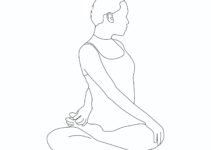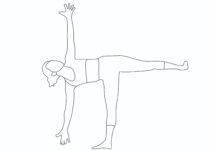The history and development of yoga is quite old. One can trace yoga in Vedas, Upanishads, Bhagavad Gita, Patanjali’s Yoga Sutra, and many more. Today, we will try to know the evolution of yoga over time.
Yoga in Vedas
- The word “yoga” surfaced around 1500 BC, just as the Harappan civilisation declined.
- Brahmanism, a complex religious tradition, introduced the concept of yoga.
- The word yoga is first mentioned in the Rig Veda, the oldest of the sacred texts. Rig Veda defines yoga as “yoking” or “discipline” but offers no accompanying systematic practice.
- The term yoga turns up again in the Atharva Veda, particularly in Vratya Kanda, the fifteenth book, where it refers only to the breath that needs control.

Fig. Patanjali (Father of Yoga)
Yoga in Upanishads
- Yoga played a more prominent role in the Upanishads.
- Two particular yoga disciplines gained prominence during this time: karma yoga, the path of action or ritual, and jnana yoga, the way of knowledge.
- One of the earliest Upanishads, Maitrayaniya Upanishad, defined yoga as binding the breath and the mind using the syllable Om.
- The Maitrayaniya took the concept of yoga a step further by presenting a six-fold yoga path that includes controlling the breath (pranayama), withdrawing the senses (pratyahara), meditation (dhyana), concentration (Dharana), contemplation (tarka), and absorption (samadhi). Elements of this six-fold path expanded somewhat and resurfaced in Patanjali’s Yoga Sutra.
Yoga in Bhagavad Gita
- The most famous and beloved yoga text, the Bhagavad Gita (“The Lord’s Song”), provides the most comprehensive description of yoga at that time.
- The Gita advocated a three-pronged approach: karma yoga, the path of service; jnana yoga, the way of wisdom or knowledge; and bhakti yoga, the direction of devotion.
- In the Bhagavad Gita, jnana yoga signified meditation.
- Karma yoga of the Gita is still a yogi’s action path, which Krishna called Arjuna’s sva-dharma.
- Buddhi yoga, the Bhagavad Gita‘s melding of karma and jnana yoga principles, taught that the yogi must never be attached to the outcome of his actions.
- The Gita dedicated most of its later chapters to bhakti-yoga, the path of devotion.
What is pre-classical yoga?
- The concept of universal consciousness, or brahman, developed out of the metaphysical teachings of the Upanishads.
- Yoga has many names: Atman, the transcendental Self, the Divine, Isvara, Purusha, pure awareness, the seer, the witness, and the knower are but a few of the more popular ones.
- Toward the middle of the pre-classical period, a radical metaphysical school called Samkhya surfaced. It owed its teachings to an obscure sage named Kapila—who developed the basis for a more modern yogic worldview.
Top facts about Patanjali’s Yoga Sutra
- The most famous proponent of the Samkhya was Patanjali, known for his renowned treatise called the Yoga Sutra, considered the first systematic presentation of yoga.
- Patanjali is the father of modern yoga.
- Patanjali succeeded in codifying the concepts of an ancient and oral tradition.
- His collection of 195 sutras (aphorisms or “terse statements”) provides the first practical treatise on daily living.
- Patanjali wrote that only hard work (karma yoga) and deep meditation (jnana yoga) could relieve human suffering and lead to liberation.
- Although he is best known as the chronicler of the eight-limbed yoga path (ashtanga yoga).
History of Tantra Yoga
- Tantra emerged early in the post-classical period, around the fourth century, representing a rather radical departure from yoga philosophy.
- Tantra rejected the Vedas as irrelevant and dismissed the Samkhyan precept.
- Tantra also eschewed karma yoga yet focused on devotion (bhakti), most notably the worship of the Goddess.
Top Facts about Hatha Yoga
- Hatha yoga’s principles arose from tantra, incorporating elements of Buddhism, alchemy, and Shaivism.
- The very name hatha yoga, a combination of “ha,” meaning sun, and “tha,” meaning moon, denotes the union of opposites.
- Hatha also means a force or determined effort.
- Hatha yoga implies that it takes a lot of strength, discipline, and effort to unify opposing forces and to bring together the body and the mind.
- The first and primary text was written by a yogi named Goraksha, the person most often deemed the father of hatha yoga.
- Svatmarama Yogin, who called himself a disciple of Goraksha, wrote a second book, the Hatha Yoga Pradipika, which describes sixteen postures, several purification rituals, eight pranayama techniques, and ten seals (mudras).
- The Gheranda Samhita of Gheranda, based on the Hatha Yoga Pradipika, offers seven niyamas: cleanliness, firmness, stability, constancy, lightness, perception, and nondefilement. It also describes 32 asanas and 25 mudras.
- But the most comprehensive and democratic treatise on hatha yoga is the Shiva Samhita, which emphasises that even an ordinary householder can practice yoga and reap its benefits.
- The Shiva Samhita outlines 84 different asanas and five specific types of prana.
History of Yoga Upanishads
- Yoga Upanishads includes a few asanas and some of the pranayama and mudras.
- One of the Yoga Upanishads, Tejo Bindu Upanishad, grafts seven new limbs onto Patanjali’s eight-limbed yoga path.
- To the precepts and disciplines (yamas and niyamas), asana, pranayama, withdrawal (pratyahara), intense concentration (dharana), meditation (dhyana), and liberation (samadhi) of the Yoga Sutra, the Tejo Bindu adds mula bandha (root locks), equilibrium, steadiness of vision, tyaga (abandonment), mauna (silence), desha (place), and kala (time).
History of Yoga in America
- American yoga primarily focuses on the physical poses called asanas and is thus clearly an offshoot of hatha yoga.
- Although jnana and the raja yoga of Patanjali’s Yoga Sutra were the first to gain momentum in the West.
- According to yoga scholar Georg Feuerstein, the Western love affair with all things Eastern began in the third century.
- Sir Charles Wilkins, a member of the Asiatic Society of Bengal, published the first English-language translation of the Bhagavad Gita in 1785.
- Sir William Jones translated Isha Upanishad.
- Henry Thomas Colebrooke wrote essays on the Vedas and yoga, particularly the Samkhya Karika and Ishvara Krishna’s commentary on Samkhya.
- In 1893, Swami Vivekananda, the first Indian spiritual teacher, spoke passionately about raja yoga at the first Parliament of World Religions held in Chicago, and the crowd went wild.
- In 1899, Swami Vivekananda set up the New York Vedanta Society dedicated to four branches of yoga practice: bhakti (devotion), karma (service), jnana (knowledge), and raja (the eight-limbed path of Patanjali’s Yoga Sutra).
- Johann Wilhelm Hauer produced a translation of Patanjali’s Yoga Sutra.
- Poul Tuxen, a Dutch scholar, wrote a history of the yoga tradition in 1911
- Krishnamurti, an Indian philosopher, drew vast followers in Gstaad, Switzerland, with yoga master B.K.S. Iyengar and, later, yogi T.K.V. Desikachar.
- In 1947, Theos Bernard, another passionate student who studied in India for many years, wrote Hatha Yoga: The Report of a Personal Experience, one of the first guidebooks to yoga asanas.
- In 1950, Richard Hittleman, a spiritual disciple of Ramana Maharshi, began teaching the physical aspects of hatha yoga in New York City.
- By 1961, thanks to television, Americans everywhere were learning a non-religious, decidedly unspiritual form of yoga exercise.
- Hittleman’s book The Twenty-Eight-Day Yoga Plan sold millions of copies and put hatha yoga on the American map.
- Ten years later, yoga teacher Lilias Folan consummated America’s love of this gentle physical form of yoga in her PBS-TV series “Stretching with Lilias.”
- Various forms of yoga, such as yoga asana and pranayama, and – the other paths—bhakti, jnana, and karma yoga continuously flourishing in the USA.





